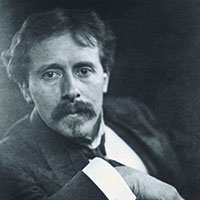
Frank Lloyd Wright meets C.R. Ashbee
By SB
As you enter Court Barn, C. R. Ashbee’s handsome image greets you from the pillar on your left. The photograph hints at the world-wide appeal of the Arts and Crafts movement, having been taken by Frank Lloyd Wright (1867-1957), the American architect and originator of the Prairie School of architecture. He and Ashbee had met during Ashbee’s lecture tour of the US in 1900, and again in Europe in 1909 when Wright was submitting lithographs of his work to the Berlin publisher, Ernst Wasmuth.

Wright, whose early interest in structure had been fostered by playing with Froebel bricks, trained as an engineer in Wisconsin and in 1887 moved to Chicago to work as a draftsman in successive architectural firms, while in his own time ‘boot-legging’ (as he called it) by designing houses. Inspired by the vistas of the American prairies, Wright’s revolutionary designs used natural materials to create houses with low-pitched roofs and open interiors.
Eventually he set up his own practice and developed his innovative style, often using strong horizontal lines with long runs of terraces and cantilevered roofs. His concept of ‘organic architecture’ led him to specify details of flooring, furniture and household objects within these buildings. In the 1920s he introduced the use of pre-cast concrete blocks, reinforced with metal bars, allowing for a variety of textured and coloured surfaces: his ‘textile’ system.
Wright’s domestic life was both tempestuous and tragic. He married three times; in 1914 one mistress died in a savage attack at Wright’s home, Taliesin, in Wisconsin; then, and again in 1925, the house was destroyed by fire. Nevertheless, Wright continued to work on domestic and public buildings, such as Falling Water, Pennsylvania (1937), and the Solomon R Guggenheim Museum, New York City (1959), while his concept of the ‘Usonian House’ was a response to the radical changes in American life-style from the 1930s. His outstanding achievements were honoured in his life time and eight of his buildings are included in the UNESCO list of World Heritage Sites.
+44 (0)1386 841951
admin@courtbarn.org.uk



October – March
Tuesday – Sunday 10am – 4pm
April – September
Tuesday – Sunday 10am – 5pm